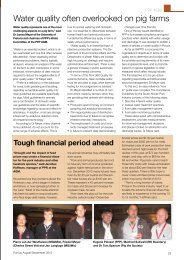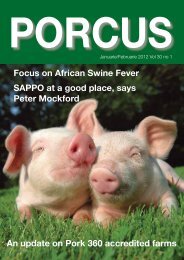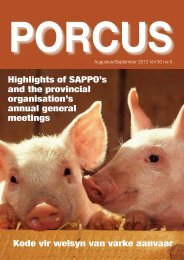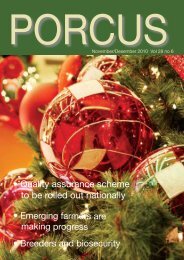Create successful ePaper yourself
Turn your PDF publications into a flip-book with our unique Google optimized e-Paper software.
Figure 4: Sow numbers vs sales 1<br />
Abattoir level analysis<br />
Market conditions<br />
The abattoir analysis focuses on two aspects, namely the<br />
total number of pigs slaughtered and number slaughtered per<br />
province.<br />
The total number of pigs slaughtered for the third levy period<br />
has decreased by 7.11% from January to February. Towards<br />
March, the number of slaughterings recovered, increasing<br />
by 16.68%. The total number of pigs slaughtered in February<br />
and March were 182 036 and 212 395 respectively. When<br />
considering a three-month moving average (MA), the number<br />
of slaughterings in March reached 196 798 animals, 1.46%<br />
lower than the MA in January as indicated in Figure 6. There<br />
was a sharp decrease in the slaughter of other livestock. The<br />
number of cattle slaughtered, decreased by 6.4% from January<br />
to March. The total number of sheep slaughtered, has declined<br />
by 11.62%. The actual slaughterings for cattle and sheep in<br />
Figure 5: Services vs piglets born 2<br />
March were 191 694 and 389 162 respectively. When considering<br />
provincial slaughters, the number of slaughters in Gauteng<br />
had a sideways movement from January towards March with<br />
87 247 animals slaughterings. There was a sharp increase in<br />
the number of slaughterings in KwaZulu-Natal and the Western<br />
Cape from January to March. Slaughterings have increased<br />
by 14.33% and 23.47% in KwaZulu-Natal and Western Cape<br />
respectively, to reach values of 33 127 and 30 461 animals<br />
slaughtered. National slaughterings could increase in the short<br />
term, due to an increased demand for the Easter holidays.<br />
During January towards March, all meat classes had sideways<br />
movements and then increased marginally towards the<br />
end of March except for PP quality pork, which followed a relatively<br />
constant trend. BP pork was the best performer in terms<br />
of marginal movements. The price in the last week of January<br />
was R15.71/kg. BP quality pork prices then moved sideways<br />
Figure 6: Total numbers slaughtered (national estimates)<br />
towards the end of February, then increased by 2.54% towards<br />
the week of the 25th of March, at a price of R16.13/kg. For the<br />
same period in 2010, the price for BP pork was R15.36/kg. The<br />
prices for BO and BR classes followed a similar trend, where<br />
both had a sideways movement towards 25th of February<br />
and then increased by 2.62% and 1.65% respectively towards<br />
the end of March. The price of BO and BR quality pork was<br />
R16.06/kg and R15.38/kg during the week of 25 March. As<br />
stated earlier, the price for PP pork products have decreased<br />
by 1.45% from the 7th of January to the 4th of February. PP<br />
prices then remained constant to the end of March where the<br />
price was R16.26/kg.<br />
Figure 7: Slaughterings per province<br />
Figure 8: Average price for various classes 3<br />
Wholesale and retail price analysis<br />
Index levels<br />
The margin analysis in the sample for porker and baconer prod-<br />
Continued on p 8<br />
Porcus April/May 2011 7







